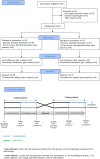Cinnamaldehyde is a biologically active compound for the disinfection of removable denture: blinded randomized crossover clinical study
- PMID: 32807162
- PMCID: PMC7433048
- DOI: 10.1186/s12903-020-01212-5
Cinnamaldehyde is a biologically active compound for the disinfection of removable denture: blinded randomized crossover clinical study
Abstract
Background: Fungal infections associated with the use of dentures, like denture stomatitis, are difficult to prevent and treat. This in situ study aimed to investigate the efficacy of cinnamaldehyde for the disinfection of complete removable dentures, and the effect on the physical and mechanical properties (Vickers microhardness, color, and surface roughness) of the acrylic resin.
Methods: Acrylic resin disks were inserted into the dentures of a probabilistic sample of 33 complete denture users, that used cinnamaldehyde (27 μg/mL) and 0.5% sodium hypochlorite solutions in a 20 min/7-days protocol of dentures immersion in each solution, with a wash-out period of 7 days, to constitute a crossover-study. The disks were analyzed before and after the immersion, for the presence of microorganisms (CFU/mL) and by scanning electron microscope (SEM). Also, the surface roughness (Ra) and Vickers microhardness were measured, and color parameters were analyzed using the National Bureau of Standards (NBS) method. Data was analyzed by Wilcoxon and Friedman (microbiological evaluation), paired t-test (color and roughness) and independent t-test (Vickers hardness) (α = 0.05).
Results: A significant reduction (P < 0.05) in the number of microorganisms was observed for each species (total microorganisms, Streptococcus mutans, and Candida spp.), with no significant differences (P > 0.05) between hypochlorite and cinnamaldehyde. There was an increase in the roughness and a decrease in the hardness of the test specimens, with no difference between the two disinfectant substances (P > 0.05). Both hypochlorite and cinnamaldehyde also caused changes in color, considered as "perceptible" by the NBS classification, but with no significant difference between disinfectant substances (P < 0.05), and under the clinically acceptable limit (ΔE ≤ 3.7).
Conclusion: The 27 μg/mL cinnamaldehyde solution was effective against all evaluated microorganisms and caused minor alterations in hardness, surface roughness, and color parameters, with no clinical relevance.
Conflict of interest statement
The authors declare that they have no competing interests.
Figures



Similar articles
-
Effects of long-term cinnamaldehyde immersion on the surface roughness and color of heat-polymerized denture base resin.J Prosthet Dent. 2022 Sep;128(3):521.e1-521.e8. doi: 10.1016/j.prosdent.2022.07.002. Epub 2022 Aug 13. J Prosthet Dent. 2022. PMID: 35970612
-
Hardness and surface roughness of enamel and base layers of resin denture teeth after long-term repeated chemical disinfection.J Contemp Dent Pract. 2015 Jan 1;16(1):54-60. doi: 10.5005/jp-journals-10024-1635. J Contemp Dent Pract. 2015. PMID: 25876951
-
Antimicrobial action and long-term effect of overnight denture cleansers.Am J Dent. 2017 Apr;30(2):101-108. Am J Dent. 2017. PMID: 29178772
-
Do denture cleansers influence the surface roughness and adhesion and biofilm formation of Candida albicans on acrylic resin? Systematic review and meta-analysis.J Prosthodont Res. 2023 Apr 12;67(2):164-172. doi: 10.2186/jpr.JPR_D_22_00077. Epub 2022 Jul 13. J Prosthodont Res. 2023. PMID: 35811135
-
Strategies for Preventing and Treating Oral Mucosal Infections Associated with Removable Dentures: A Scoping Review.Antibiotics (Basel). 2024 Mar 18;13(3):273. doi: 10.3390/antibiotics13030273. Antibiotics (Basel). 2024. PMID: 38534708 Free PMC article.
Cited by
-
Biofilm inhibition of denture cleaning tablets and carvacrol on denture bases produced with different techniques.Clin Oral Investig. 2024 Jul 5;28(7):413. doi: 10.1007/s00784-024-05810-3. Clin Oral Investig. 2024. PMID: 38965139 Free PMC article.
-
Pathogenesis and preventions of denture stomatitis.Zhong Nan Da Xue Xue Bao Yi Xue Ban. 2023 Sept 28;48(9):1411-1418. doi: 10.11817/j.issn.1672-7347.2023.230092. Zhong Nan Da Xue Xue Bao Yi Xue Ban. 2023. PMID: 38044653 Free PMC article. Chinese, English.
-
Natural compounds: new therapeutic approach for inhibition of Streptococcus mutans and dental caries.Front Pharmacol. 2025 Apr 1;16:1548117. doi: 10.3389/fphar.2025.1548117. eCollection 2025. Front Pharmacol. 2025. PMID: 40235544 Free PMC article. Review.
References
-
- Gleiznys A, Zdanavičienė E, Žilinskas J. Candida albicans importance to denture wearers. A literature review. Stomatologija. 2015;17:54–66. - PubMed
-
- Emami E, Taraf H, Grandmont P, Gauthier G, Koninck L, Lamarche C, Souza RF. The association of denture stomatitis and partial removable dental prostheses: a systematic review. Int J Prosthodont. 2012;25:113–119. - PubMed
Publication types
MeSH terms
Substances
LinkOut - more resources
Full Text Sources
Medical
Research Materials
Miscellaneous

